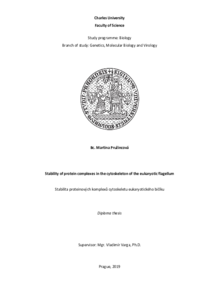Stability of protein complexes in the cytoskeleton of the eukaryotic flagellum
Stabilita proteinových komplexů cytoskeletu eukaryotického bičíku
diplomová práce (OBHÁJENO)

Zobrazit/
Trvalý odkaz
http://hdl.handle.net/20.500.11956/109457Identifikátory
SIS: 186369
Katalog UK: 990022935560106986
Kolekce
- Kvalifikační práce [21483]
Autor
Vedoucí práce
Oponent práce
Čajánek, Lukáš
Fakulta / součást
Přírodovědecká fakulta
Obor
Genetika, molekulární biologie a virologie
Katedra / ústav / klinika
Katedra genetiky a mikrobiologie
Datum obhajoby
10. 9. 2019
Nakladatel
Univerzita Karlova, Přírodovědecká fakultaJazyk
Angličtina
Známka
Výborně
Klíčová slova (česky)
cília, bičík, axonéma, proteínová obmena, inkorporácia proteínov, Trypanosoma brucei, HaloTagKlíčová slova (anglicky)
cilium, flagellum, axoneme, turnover, protein incorporation, Trypanosoma brucei, HaloTagCília/bičík je komplexná organela vystupujúca z tela bunky, ktorá môže mať niekoľko funkcií, ako napríklad pohybovú, senzorickú alebo signálnu. Bičík je zostavený zo stoviek proteínov, ktorých väčšina tvorí kostru - mikrotubulárnu axonému. Pretože bičík neobsahuje ribozómy, proteíny, ktoré sa podieľajú na jeho stavbe a funkcii, musia byť dovážané z tela bunky a inkorporované na správne pozície. Navyše, tieto proteíny si musia zachovávať svoju funkciu počas dlhého obdobia, a to napriek tomu, že sú vystavené mechanickému a environmentálnemu stresu. Tieto skutočnosti vzbudzujú otázku, či a kde dochádza v bičíku k výmene proteínov. Predchádzajúce štúdie bičíkov na Chlamydomonas reinhardtii prezentovali, že bičík je dynamická štruktúra (Marshall & Rosenbaum, 2001). Naopak, štúdie na Trypanosoma brucei ukázali, že bičíky tohto organizmu sú pozoruhodne stabilné (Vincensini et al., 2018). Avšak to, akým spôsobom sa bičík vytvára a stabilizuje, bolo doteraz skúmané iba na veľmi malom počte proteínov a iba v krátkych časových intervaloch. Navyše, tieto experimenty využívali expresiu študovaných proteínov s neprirodzenými regulačnými mechanizmami. Na objasnenie detailov spôsobu fungovania proteínovej obmeny v bičíku bola v tejto práci použitá T. brucei. Jedným z dôvodov výberu tohto modelového organizmu bolo...
The cilium/flagellum is a complex organelle protruding from the cell body and functioning in motility, sensing, and signalling. It is composed of hundreds of protein constituents, the majority of which comprise the flagellar cytoskeleton - the microtubule-based axoneme. Because the flagellum lacks ribosomes, its protein constituents have to be imported from the cell body and delivered to proper locations. Moreover, these proteins have to retain their function over a considerable length of time, despite the mechanical stress caused by flagellar beating and due to environmental exposure. This raises the question whether and where protein turnover occurs. Previously, it was established that Chlamydomonas reinhardtii flagella are dynamic structures (Marshall & Rosenbaum, 2001). In contrast, in the Trypanosoma brucei flagellum axonemal proteins are remarkably stable (Vincensini et al., 2018). However, the questions of axonemal assembly and stability were so far investigated only for a small number of proteins and during relatively short periods. Moreover, in these experiments expression of studied proteins was controlled by non-native regulatory elements. To elucidate the site of incorporation of proteins from all major axonemal complexes and to find out if and where the protein turnover occurs, T....
